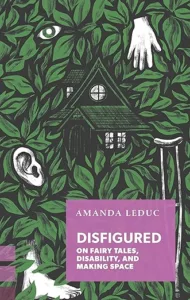Disfigured: On Fairytales, Disability, and Making Space
Amanda Leduc
Coach House Books
Published March 3, 2020
Amazon | Bookshop | Goodreads
About Disfigured
In fairy tales, happy endings are the norm—as long as you’re beautiful and walk on two legs. After all, the ogre never gets the princess. And since fairy tales are the foundational myths of our culture, how can a girl with a disability ever think she’ll have a happy ending?
By examining the ways that fairy tales have shaped our expectations of disability, DISFIGURED will point the way toward a new world where disability is no longer a punishment or impediment but operates, instead, as a way of centering a protagonist and helping them to cement their own place in a story, and from there, the world. Through the book, Leduc ruminates on the connections we make between fairy tale archetypes—the beautiful princess, the glass slipper, the maiden with long hair lost in the tower—and tries to make sense of them through a twenty-first-century disablist lens.
From examinations of disability in tales from the Brothers Grimm and Hans Christian Andersen through to modern interpretations ranging from Disney to Angela Carter, and the fight for disabled representation in today’s media, Leduc connects the fight for disability justice to the growth of modern, magical stories, and argues for increased awareness and acceptance of that which is other—helping us to see and celebrate the magic inherent in different bodies.
My Review
I heard about this book years ago from booktuber Jesse on YouTube, who read and recommended it. Sadly, it took me a long time to actually read the book myself, but I finally have! And I’m so glad I did.
This book explores fairytales through the lens of what it’s like to read them as a person with disabilities. The author not only shares her own experience as a girl with cerebral palsy, but she also quotes and shares stories of other writers and activists with disabilities as they share their own experiences as well.
One of the things I found the most impactful about DISFIGURED was seeing different fairytale characters and stories from this perspective. There were many things I hadn’t considered or was unaware of. It helped to break things down into tropes and themes and look at what those ideas say about the value or morality of those characters and through the characters the people represented.
For example, the author talks about how often in fairytales, characters with disabilities fall into two categories. Either they are noble characters whose disabilities become reversed because they were pure of heart or brave or noble. Or the disability is supposed to be evidence of an internal evil that remains a static part of the character’s nature.
There’s also some commentary about the differences in the roles of women versus men in fairytales, too. I enjoyed that a lot.
All in all, DISFIGURED is a really thoughtful book that explores familiar fairytales, where they came from, and what they teach us about who we are and what society should be. And asks whether we agree with those lessons and, if not, what we will do about it.
Content Notes
Recommended for Ages 14 up.
Representation
The author has Cerebral Palsy. She quotes other disabled writers and activists.
Profanity/Crude Language Content
Very infrequent extreme profanity.
Romance/Sexual Content
References to fairytale romance/weddings. Leduc recounts an early version of what became the Sleeping Beauty fairytale in which a maiden pricks her finger on a flax seed and falls into a magical sleep. A traveling king sees her and is so overcome with lust that he rapes her (not described in any detail). The author points out that the story never addresses the king’s behavior as problematic, wrong, or illegal.
The author references an essay written by a man with disabilities who openly talks about hiring sex workers to meet his personal needs. (No details beyond this.)
Spiritual Content
Discusses the origins of the fairy godmother/fairies in fairytales. Examines the Christian (Calvinist, in the case of the Grimm Brothers) roots or edits to many fairytales in subsequent editions. Mentions of magic in stories.
In one tale, the devil tricks a man into promising his daughter to him. The girl thwarts the bargain several times.
Violent Content
References to some gory elements of especially early fairytales. Cinderella’s stepsisters mutilate their feet to fit into her shoe. The evil queen in Snow White is forced to dance in red-hot metal shoes until she dies at the tale’s end. See romantic content.
The author also discusses the changeling myths and how people would leave their babies or young children in the snow to die of exposure if they believed the baby was a changeling. She briefly tells a story about a man who burned his wife to death. He claimed she’d been replaced by a changeling after an illness.
Drug Content
Mentions of magical potions or poisoned fruit.
Note: This post contains affiliate links, which do not cost you anything but help support this blog.

















